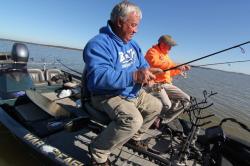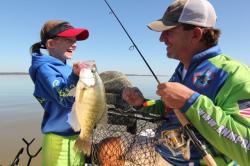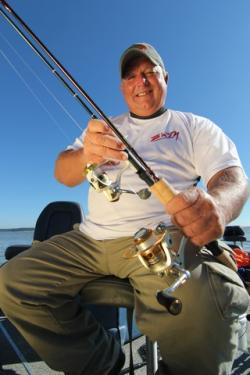Casting for Crappie
from The Fishing Wire
As with all fishing, catching crappie by casting requires that you put yourself where the fish are, whether you’re in a $40,000 boat or walking the bank.
For crappie anglers in most areas, the best time to cast for crappie is in the springtime when the fish are up shallow spawning. Crappie will get up on the bank searching for spawning areas and make nests around cover or structure. Making target specific casts to cover and structure is the best way to catch these crappie.
“Casting is a great way to get the bait or lure in front of the fish without spooking them when they’re up shallow,” says B’nM’ crappie pro staffer Brad Taylor.
It’s not just Brad Taylor using a spinning rod and reel when casting for crappie. His daughter, Allie Bre, one of his favorite fishing partners, also loves to cast and catch crappie. “It’s a great time to take out your children and let them cast a live minnow or lure by themselves without having to help them and they can honestly catch a fish by themselves,” said Taylor.
One of Taylor’s favorite crappie fishing spots is the renowned Grenada Lake in Mississippi. “Early in the year, I like to fish the grass on Grenada Lake since there is no structure to speak of here. I usually fish with a live minnow or Southern Pro Lit’l Hustler 1 ½-inch tube rigged on a 1/32- or 1/16-ounce jig head,” said Taylor.
For live minnows, Taylor uses a #2 Eagle Claw 214EL light wire hook and #4 split shot. “Since the water is muddy on Grenada Lake, I can rig up with 8 pound test line when fishing with live minnows or even tubes,” said Taylor.
Taylor likes to rig with a cork and keep the tube lure just above where the crappie are located.“Most the time on Grenada, I’m in about three feet of water catching them,” said Taylor.
Casting light offerings can be challenging for the novice angler. However, a spinning reel can help eliminate some of the problems associated with casting especially live minnows or lightweight lures. Spinning reels have a fixed spool that doesn’t rotate. Instead the fishing line flows off the spool by being pulled from the weight of the lure.
One reel especially effective for this duty is the WaveSpin spinning reel (www.wavespinreel.com) with a unique star-shaped spool lip that the company says is much less likely to cause tangles than conventional designs. Reportedly the design can also increase casting distances due to reduced line drag. The revolutionary spool features a row of teeth all slanted in one direction with gaps between the teeth reducing friction at the same time eliminating tangles. The reels have aluminum spools, all metal gears, over-sized line roller, infinite anti-reverse and an exclusive 10 disc drag system.
Two anglers that don’t have any problems casting spinning rods and reels are B’n’M’s pro staff manager Kent Driscoll and B’n’M’ pro staffer/Grenada Lake fishing guide John Harrison (www.crappie101.com) who fish together in crappie tournaments. Both like to cast spinning rods and reels especially to stake beds. Stake beds are man-made structure commonly constructed from wood or PVC pipe to attract crappie.
“When fishing stake beds, we approach them going into the wind because we can control the boat better and that lets us keep our distanced from the stake bed,” said Harrison.
“We use live minnows, live minnows rigged on a jig with a soft plastic body or a 1/16-ounce jig. Normally, we will just cast past the stake bed and twitch it, pause, twitch, pause retrieve back through the stake bed,” said Driscoll.
When it comes to crappie rods Taylor, Driscoll, and Harrison like using the B’n’M’ Poles Sam’s Super-Sensitive 7-Foot Crappie Rod (www.bnmpoles.com) or Buck’s Graphite Crappie Spinning rod. Both are lightweight graphite rods design just for casting live minnows or casting lures.Spinning reels and rods make casting live minnows and lures so easy any angler can do it. Then it’s a matter of cleaning the fish and heating up the cooking oil.


